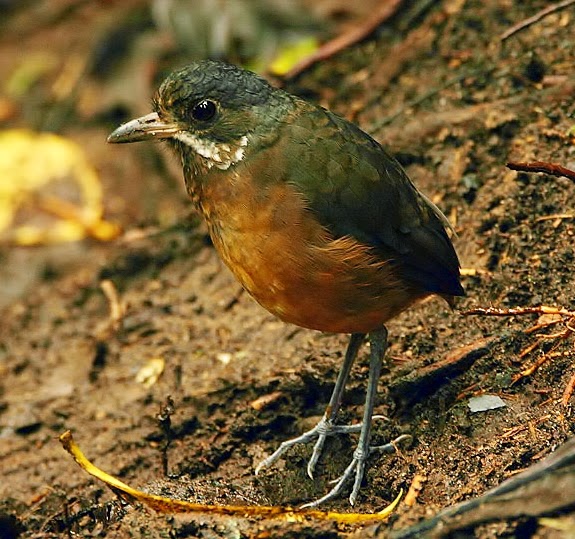 |
| Photo by Steve Blain (Steve Blain presents “Bird Porn”) |
Common name:
moustached antpitta (en); tuvacuçu-de-bigodes (pt); grallaire à moustaches (fr); tororoí bigotudo (es); grauscheitel-ameisenpitta (de)
Taxonomy:
Order Passeriformes
Family Formicariidae
Range:
This species is only found in the western slope of the Central Andes in Colombia, and both Andean slopes in northern Ecuador.
Size:
These birds are 16-17 cm long and weigh 60-80 g.
Habitat:
The moustached antpitta is found in dense understorey of moist, mossy cloud forests, particularly in ravines and steep slopes. They are present at altitudes of 1.800-2.500 m.
Diet:
They forage on the ground, taking earthworms and insects, namely katydids.
Breeding:
Moustached antpittas nest in a cup made of dead leaves, sticks and moss, placed on a small branch or trunk of a tree, about 1,5 m above the ground. The female lays 2 unmarked eggs. There is no available information about the incubation period, but the chicks fledge 15-17 days after hatching.
Conservation:
IUCN status – VU (Vulnerable)
This species has a relatively small and fragmented breeding range, and the global population is estimated at 1.500-7.000 individuals. The population is suspected to be declining a a slow rate due to habitat loss. Since the 17th century, most of the cloud forest in the central Andes of Colombia has been logged, settled and converted to agriculture, while the west Andean slopes in Ecuador have also been strongly altered and fragmented. The few remaining areas suffer from human encroachment and clearance for agriculture and opium production. In the east Andes some well protected forests remain with roughly 60% of the range of the moustached antpitta in that region being included in five protected areas.







